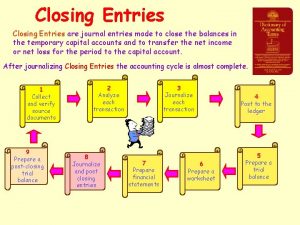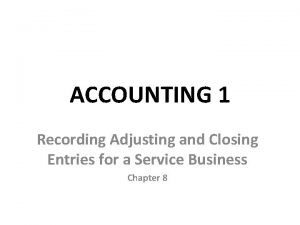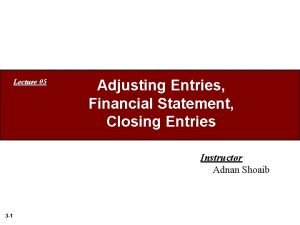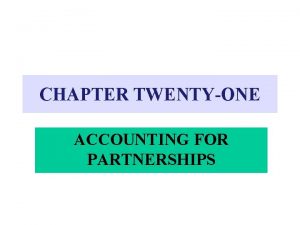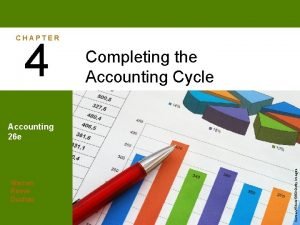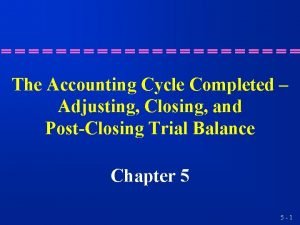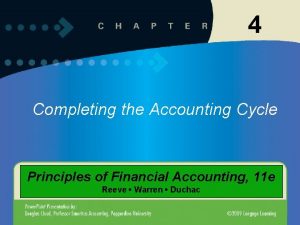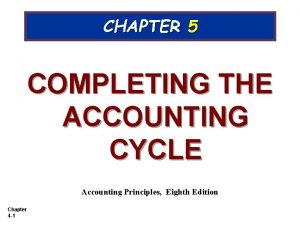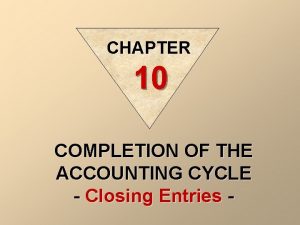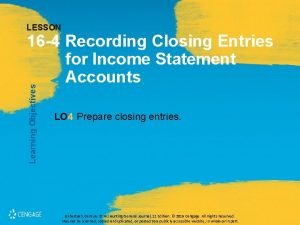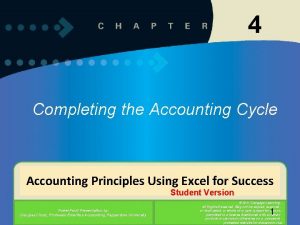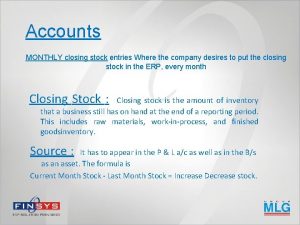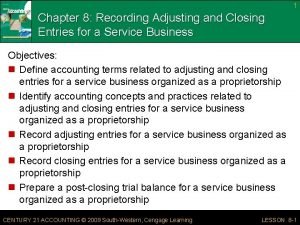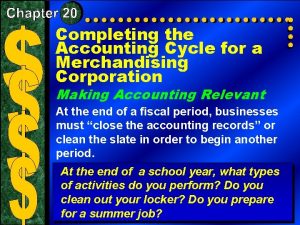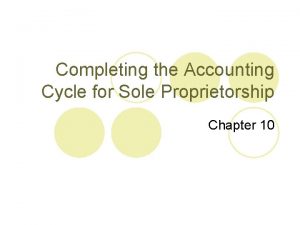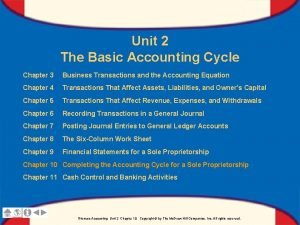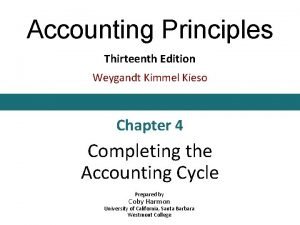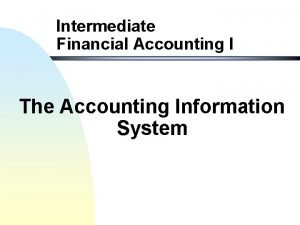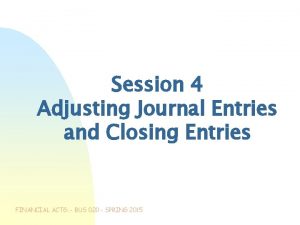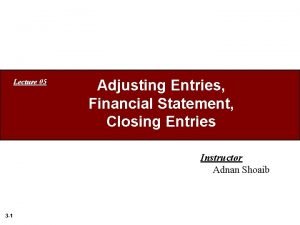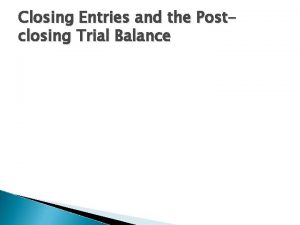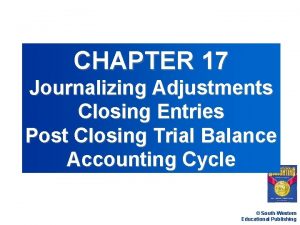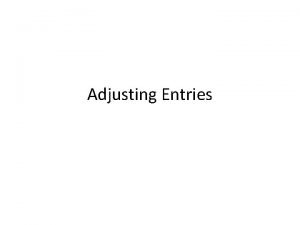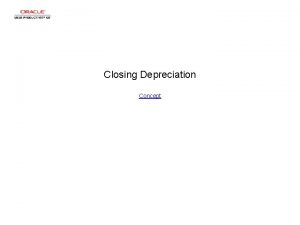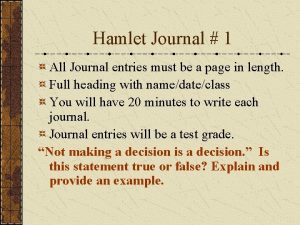Closing Entries are journal entries made to close
























- Slides: 24

Closing Entries are journal entries made to close the balances in the temporary capital accounts and to transfer the net income or net loss for the period to the capital account. After journalizing Closing Entries the accounting cycle is almost complete. 1 Collect and verify source documents 9 Prepare a post-closing trial balance 2 Analyze each transaction 8 Journalize and post closing entries 3 Journalize each transaction 7 Prepare financial statements 6 Prepare a worksheet 4 Post to the ledger 5 Prepare a trial balance

The Purpose of Closing Entries The net income appears on the income statement Net income is included in ending capital balance. Ending capital balance goes on the balance sheet. This capital balance does not match the capital balance in the general ledger.

The Income Summary Account It’s about time we started using this account. How do we use the income summary account? Income Summary is used to accumulate and summarize the revenue and the expenses for the accounting period. Income Summary is a simple version of the income statement for the period. Revenue goes in as a credit, and expenses go in as debits. The balance of Income Summary is the net income or net loss for the accounting period. Income Summary Debit Credit Expenses Revenue Debit balance Means Net Loss Credit balance Means Net Income

Quick Summary of Closing Entries • The balance of the revenue account is transferred to Income Summary • The expense balances are transferred to Income Summary • The balance of Income Summary is transferred to the Capital account • The balance of withdrawals is transferred to the Capital account

Revenue Closing Entry Since a revenue account has a credit balance, in order to make the balance zero, the account must be debited. Since for every debit there must be a credit of equal value, Income Summary is credited. Remember to always keep balance Daniel Son. Refer to the worksheet on page 192 of your textbook to follow the examples.

Expense Closing Entry Since an expense account has a debit balance, in order to make the balance zero, the account must be credited. Since for every credit there must be a debit of equal value, Income Summary is debited. Debit Income Summary for the total of all expenses, and credit each individual expense account.

Income Summary Closing Entry Let’s take a look at what the income summary account looks like. Since income summary has a credit balance, in order to make the balance zero, the account must be debited. Income Summary 1, 500 2, 650 1, 150 Bal A credit balance represents a net income. Since for every debit there must be a credit of equal value, capital is credited. A credit to capital increases the net worth of the company.

Withdrawals Closing Entry Since withdrawals has a debit balance, in order to make the balance zero, the account must be credited. Since for every credit there must be a debit of equal value, capital is debited. When the closing entries are complete, all the temporary accounts have zero balances, and the capital account has the balance that was calculated as the ending balance on the Statement of Changes in Owner’s Equity.

Completed Closing Entries 1) Close Revenue Accounts 3) Close Income Summary Account 2) Close Expense Accounts 4) Close Withdrawal Account

Posting the Revenue Closing Entry

Posting the Expense Closing Entry (1)

Posting the Expense Closing Entry (2)

Posting the Income Summary Closing Entry

Posting the Withdrawal Closing Entry









Problem 10 -4 1) Close Revenue Accounts 3) Close Income Summary Account 2) Close Expense Accounts 4) Close Withdrawal Account

 Antigentest åre
Antigentest åre Closing journal entries example
Closing journal entries example Adjusting and closing entries
Adjusting and closing entries Closing entries
Closing entries Closing entries in partnership
Closing entries in partnership Statement of owner's equity example
Statement of owner's equity example Journalizing and posting adjusting and closing entries
Journalizing and posting adjusting and closing entries Kelly consulting closing entries
Kelly consulting closing entries Closing entries example
Closing entries example Ex 4-17 closing entries with net loss
Ex 4-17 closing entries with net loss Post closing entries
Post closing entries Closing entries dividends
Closing entries dividends 10-1 preparing closing entries
10-1 preparing closing entries Kelly consulting closing entries
Kelly consulting closing entries Worksheet 10 columns
Worksheet 10 columns 10-6 journalizing closing entries
10-6 journalizing closing entries Monthly closing entries
Monthly closing entries Post-closing trial balance
Post-closing trial balance Closing entries in accounting
Closing entries in accounting Closing entries for merchandising
Closing entries for merchandising Journal entries of sole proprietorship
Journal entries of sole proprietorship 10-1 preparing closing entries
10-1 preparing closing entries Closing entries example
Closing entries example Intermediate financial accounting
Intermediate financial accounting Freedom writers journal entries
Freedom writers journal entries

